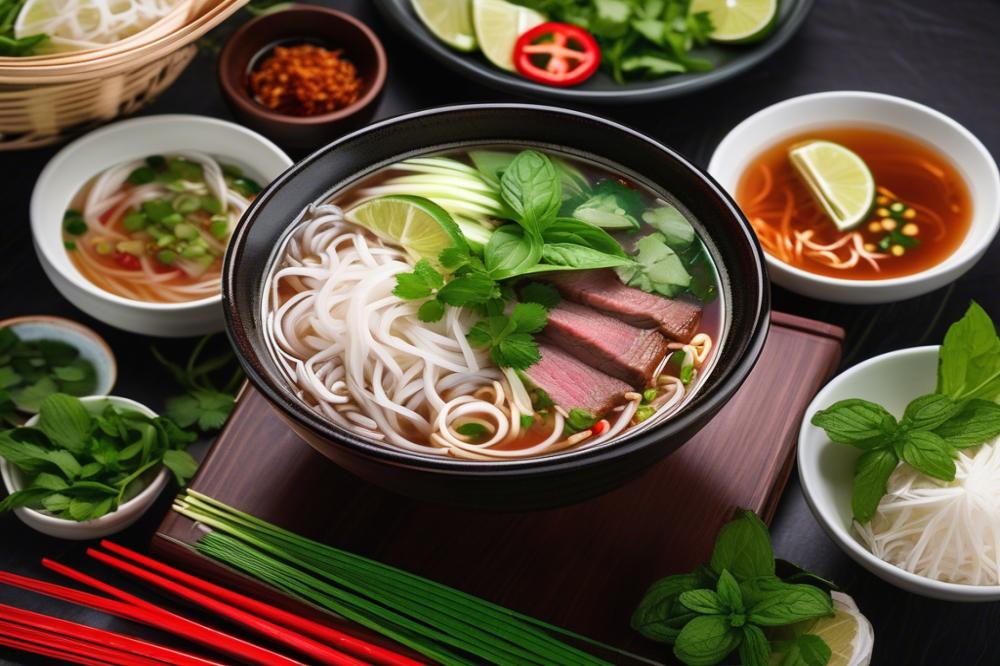Introduction
Vietnamese Pho is more than just a dish; it is a beloved noodle soup that holds a special place in the hearts of many. Originating from Vietnam, it showcases the country’s rich culinary heritage. People enjoy this delicacy in various settings, from street stalls to family gatherings. The unique combination of flavors and textures in this meal creates a comforting experience for anyone who tastes it.
At the heart of this dish is a deeply flavored beef broth. This broth takes hours of simmering to reach its full potential. The right balance of herbs and spices, such as star anise and ginger, enhances its profile. Rice noodles serve as a perfect vehicle for the broth, while toppings like bean sprouts, lime, and cilantro add freshness. Each ingredient contributes to the overall experience, making the soup vibrant and nourishing.
Cooking techniques play a critical role in making authentic cuisine. Chefs across Vietnam have passed down their methods through generations. Many families cherish their own Pho Recipe, sharing it with loved ones. Community and culture connect deeply through food, especially with this particular soup. Pho not only delights the taste buds but also brings people together, reinforcing bonds and creating memories.
Understanding Vietnamese Pho
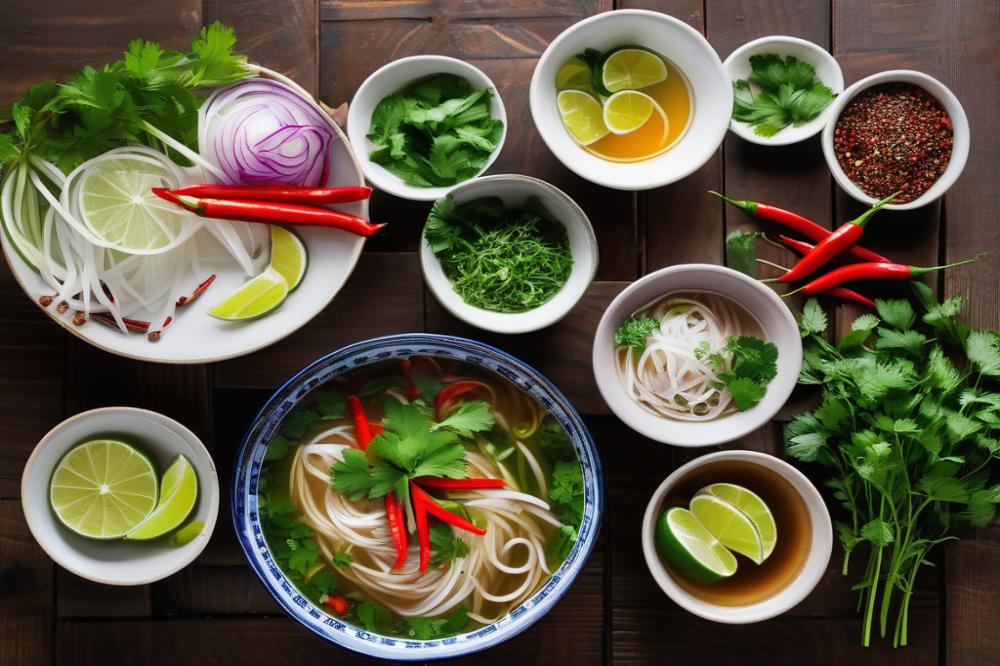
History of Pho and its Evolution as a Dish
Pho has a rich history that reflects Vietnam’s culture and traditions. It is believed to have originated in the early 20th century in northern Vietnam. Initially, it was a street food enjoyed by many. beef broth formed the backbone of this dish. Over time, Pho spread throughout the country, adapting to local tastes and ingredients. The French influence added a new dimension to its development. Ingredients like star anise and cinnamon became popular over the years. War and migration also played critical roles in its evolution. Ultimately, Pho transformed from a simple meal into an international favorite.
Different Regional Variations of Pho in Vietnam
Vietnam is home to various types of this beloved noodle soup. Northern Pho typically uses a clear beef broth with flat rice noodles. It is often garnished simply, allowing the broth’s flavor to shine. In contrast, Southern Pho is known for its vibrant herbs and fresh bean sprouts. Lime and cilantro often grace the bowl, accentuating the dish’s freshness. Central Vietnam adds its twist, infusing flavors from local cuisines. Each region showcases unique cooking techniques that reflect local culture. Tasting Pho from different areas provides an exciting culinary journey.
Key Components that Define Authentic Vietnamese Pho
Certain elements create the authentic experience of Pho. A well-prepared broth is crucial; it should be rich and aromatic. Fresh rice noodles offer a soft and chewy texture, enhancing the overall meal. Choosing the right cut of beef can elevate the dish. People often prefer brisket or rare steak for their tenderness. Herbs play a significant role in flavor as well. Common additions include Thai basil and bean sprouts. A squeeze of lime brightens every bite, providing a refreshing contrast. Together, these components create a satisfying bowl that captures the essence of Vietnamese cuisine.
Essential Ingredients for Authentic Vietnamese Pho
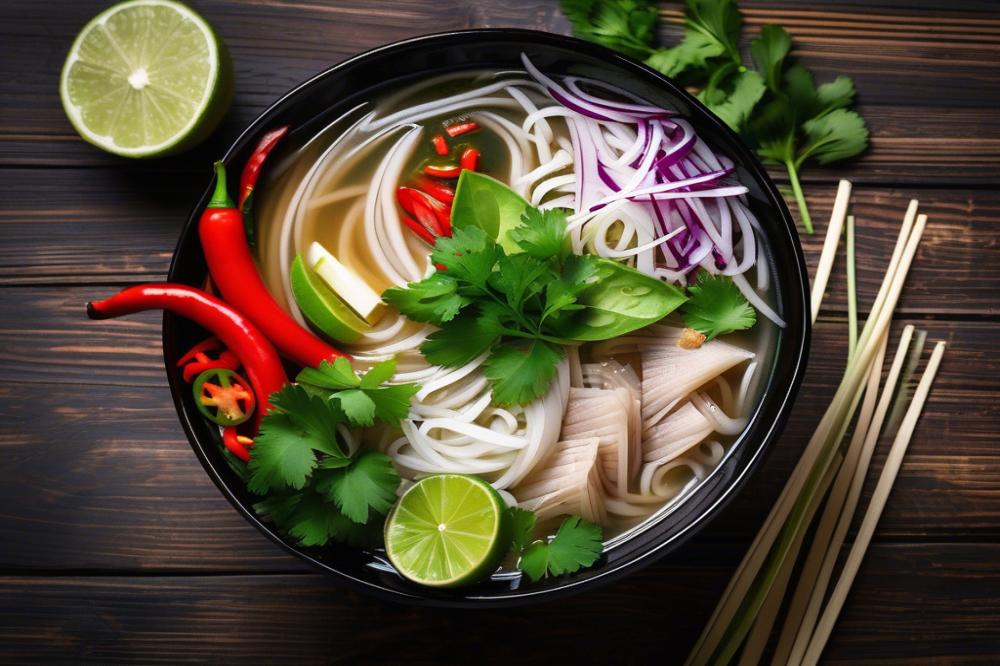
Making the perfect noodle soup requires specific ingredients. Start with 2 pounds of beef bones. This provides a rich base for the broth. You will also need 4 quarts of water. This amount helps in extracting flavors from the bones.
Ginger is essential for depth of flavor, so have 1 large piece on hand. Cut it in half for maximum infusion. Onions are similarly important. Use 1 large onion, halved, to contribute sweetness to the broth.
The addition of spices brings the final touch to this dish. Four pods of star anise offer a licorice-like hint. Cloves, five whole ones, add warmth, while one cinnamon stick enhances the aroma and flavor.
Fish sauce is a key ingredient. Use 3 to 4 tablespoons for that salty, savory element. Rice noodles, about 1 pound, will serve as the main carbohydrate source. These noodles are light and absorb the broth beautifully.
When it comes to freshness, don’t skimp on herbs. Include basil, cilantro, and green onions for aromatic qualities. These fresh herbs elevate the whole experience of the dish. In addition to these, bean sprouts provide crunch. A cup of sprouts adds texture and freshness to each bowl.
Completing your bowl is simple. A lime, cut into wedges, adds a zesty brightness to the flavors. If you enjoy heat, chili peppers are a good option. Add them according to your taste preference to create your ideal level of spiciness.
Nutritional Information for Each Ingredient
Beef bones are not just for flavor; they’re a source of protein and essential minerals. Water is, of course, calorie-free but crucial for hydration.
Ginger has anti-inflammatory properties. This spice may help with digestion too. Onions are rich in vitamins and antioxidants, which can boost overall health.
Star anise contributes unique antioxidants, while cloves are known for their anti-bacterial properties. Cinnamon is not only flavorful; it may help lower blood sugar levels.
Fish sauce, while high in sodium, also provides some protein. Rice noodles serve as a gluten-free choice rich in carbohydrates, providing energy. Fresh herbs are packed with vitamins A, C, and K.
Bean sprouts are low in calories and rich in vitamins C and K. They also provide a crunch that many enjoy. Lime is refreshing and adds vitamin C, supporting the immune system. Lastly, chili peppers contain capsaicin, renowned for boosting metabolism.
Overview of Health Benefits Associated with Traditional Pho Ingredients
Combining these ingredients creates not just a delightful meal but a healthful one too. Each item contributes something valuable. The broth offers nourishment and hydration. Fresh components like herbs and sprouts enhance both flavor and health benefits.
Cooking techniques play an important role here as well. Simmering the bones for hours helps extract collagen and nutrients. This process deepens flavors and provides a comforting bowl of soup.
Enjoying authentic cuisine like Pho brings warmth to your table. The health advantages make it even better. This meal is a celebration of flavors that nourish your body and soul.
Cooking Instructions for Authentic Vietnamese Pho
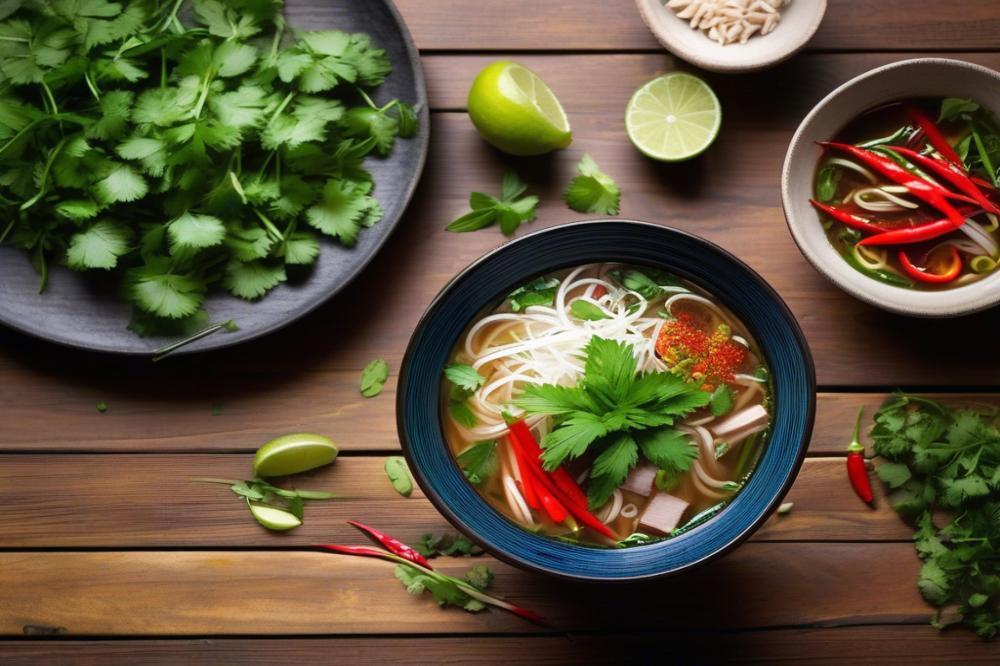
Step-by-step Guide on How to Prepare the Beef Broth
Making authentic pho starts with a rich beef broth. Begin by roasting beef bones. This step enhances the flavor. Place them in the oven at a high temperature. Roast for about 30 minutes until browned. Roasting will draw out deep flavors.
Next, add vegetables. Onions and ginger work perfectly. Slice the onion in half and char it. Do the same with the ginger, giving it a smoky taste. Roasting these ingredients adds complexity to your broth.
Now gather your spices. Star anise, cloves, and cinnamon are essential. These warm spices bring a unique aroma. Toss them in a dry pan over medium heat to toast slightly. To enhance flavor, include a bit of fish sauce during the simmering process.
Combine the roasted bones, vegetables, and toasted spices in a large pot. Fill it with water, covering everything well. Bring this mixture to a boil. Afterward, lower the heat. Allow it to simmer for at least six hours. The longer it cooks, the better the flavor.
Preparing the Rice Noodles and Assembling the Soup
While the broth cooks, prepare the rice noodles. Soak them in hot water until they are tender. Drain them well before serving. Noodles should be fresh and chewy for the best experience.
Once the broth has developed a rich flavor, strain it into a separate pot. Discard the solids. You now have a beautiful beef broth filled with taste. Adjust the seasoning to more closely mimic authentic cuisine if needed.
To assemble the noodle soup, place the soft rice noodles in a bowl. Ladle the hot broth over the noodles generously. This process warms the noodles, making the dish enjoyable.
Garnishing and Serving Tips with Fresh Herbs and Lime
Garnishing transforms your dish into a work of art. Fresh herbs play a crucial role in pho. Add basil, cilantro, and mint on top. These herbs provide freshness and color.
Bean sprouts add an interesting crunch. Place a handful in each bowl. Slices of lime add a hint of acidity and brightness. They can be squeezed over the soup according to personal taste.
Don’t forget the chili slices if you enjoy heat! Serve everything family-style. This allows guests to customize their bowls. Enjoy your well-crafted noodle soup filled with flavor and warmth on every spoonful.
Cooking Techniques for Authentic Vietnamese Pho
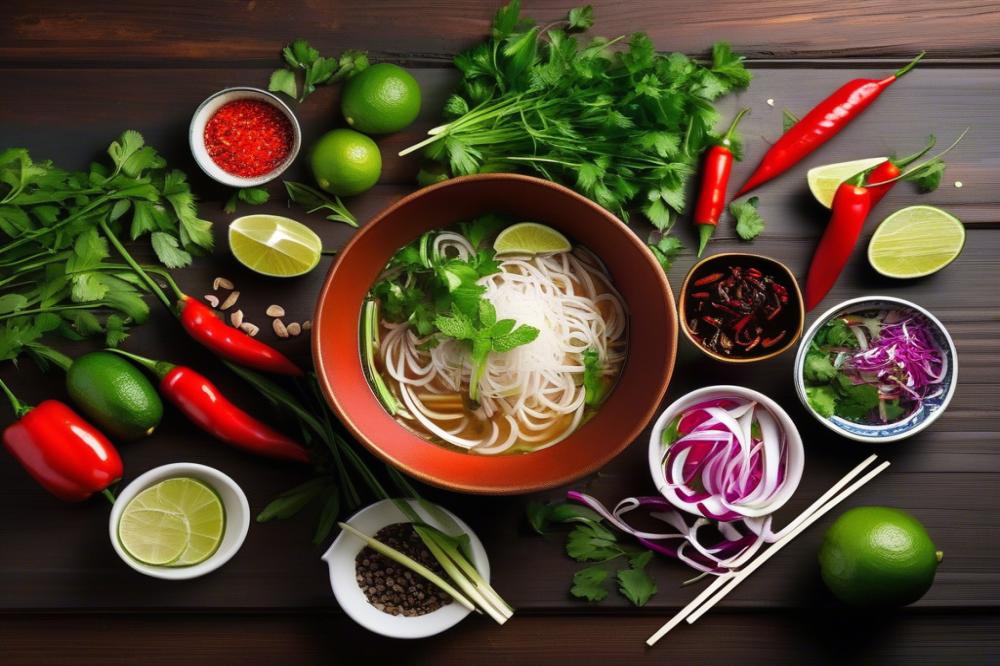
Broth Preparation and Timing
Creating the perfect beef broth is the heart of this noodle soup. It begins with bones. Use beef bones, ideally from the leg or marrow, for a rich flavor. Roasting them in the oven first adds depth. Once the bones are ready, simmer them in a large pot of cold water. Bring the mixture to a boil, then reduce to a gentle simmer. Skim off any foam that rises to the top during the first half hour. This step is crucial for clarity. As the broth cooks, add onion, ginger, and spices like star anise and cloves. Let everything simmer for hours, ideally around six, to extract all the goodness. The longer it simmers, the richer it becomes.
Noodle Cooking Tips
Rice noodles are the foundation of this dish. Cook them separately to avoid soaking up too much broth flavor. Soak dry rice noodles in hot water for about 20 minutes until soft. Then, drain and rinse them under cold water. This helps stop the cooking process. When ready to serve, quickly heat the noodles in boiling water for a minute. They should be hot but not overcooked. Place them in a bowl and ladle the rich broth over them. This timing is key for maintaining the texture of the noodles.
Balancing Seasoning for Authentic Taste
Seasoning can make or break this dish. Start with salt to enhance the natural flavors of the broth. Add fish sauce for a unique umami kick. Adjust to your taste, but remember, balancing is essential. Fresh herbs like basil, cilantro, and lime juice bring the dish to life. Bean sprouts add crunch and freshness. Consider placing these toppings on the table, allowing everyone to customize their bowls. This not only encourages personal preference but adds to the communal dining experience. Experiment with different spices, but keep it simple to maintain authenticity. Capturing the essence of this beloved cuisine is all about harmony and balance.
Serving Suggestions
How to Serve Pho Traditionally
A bowl of pho is more than just a simple dish; it is an experience. Serve the steaming beef broth over fresh rice noodles for the perfect base. Ensure that the bowl is large enough to hold generous portions. Presentation matters, so consider using a deep bowl that showcases the soup. Traditionally, pho is enjoyed hot and fresh, right from the kitchen. Garnish the top with freshly sliced meat and a sprinkle of green onions for added color.
Accompaniments: Sauces, Herbs, and Side Dishes
Many accompaniments enhance the flavors of this noodle soup. Bean sprouts are a must-have, adding crunch and texture. Fresh herbs such as Thai basil and cilantro can brighten up the dish. Spicy sauces, like sriracha or hoisin, are common for those who crave more heat. Lime wedges provide a refreshing acidity that perfectly balances the deep flavors of the broth.
In addition to these, consider serving a side of chili peppers for extra zest. Diners can mix and match these ingredients, tailoring each bowl to their liking. The act of customizing the meal brings a unique experience to the dining table.
Ideas for Customizing Pho to Suit Personal Tastes
Flexibility is a key characteristic of authentic Vietnamese cuisine. Feel free to alter the types of meat used. Popular options include grilled chicken or pork, alongside the traditional beef. For a vegetarian twist, consider using tofu and vegetable broth instead of beef.
Additionally, experimenting with cooking techniques can yield different textures and flavors. A quick sauté of the herbs can release essential oils, enhancing the aroma. Consider adding extra noodles or even rice if you prefer a heartier meal.
All of these elements come together to make your pho experience personal and memorable. Enjoying each bowl of this iconic soup is about exploration and creativity.
Final Thoughts on Crafting a Culinary Tradition
Making authentic Vietnamese Pho is more than just preparing a meal. It is a lesson in culture and tradition. This noodle soup embodies the spirit of Vietnam. Each ingredient plays a vital role, from fresh herbs to the rich beef broth simmering for hours. By understanding these components, you dive deeper into the heart of Vietnamese cuisine.
Trying to cook this dish at home can be a delightful adventure. It might feel daunting at first, but the process is rewarding. Imagine waking up to the aroma of spices and simmering broth filling your kitchen. This experience is something special that you can share with friends and family. Enjoying a bowl of homemade Pho can transport you straight to the bustling streets of Hanoi.
The joy of preparing Pho lies not only in the cooking but also in the sharing. Gathering around the table with loved ones enhances the flavor of the meal. As everyone enjoys a warm bowl of noodle soup, stories and laughter become part of the feast. This dish is a bridge connecting people, cultures, and memories.
Embrace the challenge of making this beloved dish. Through each step, you gain more than just cooking skills; you obtain a connection to a vibrant culture. So gather your ingredients, roll up your sleeves, and start your Pho journey. You might just discover a new family favorite that becomes a part of your culinary traditions.

